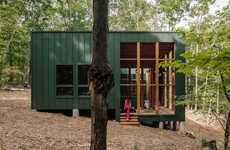Famous architect Zaha Hadid designed a new structure along New York's High Line, and to thoughtfully minimize the effect of this building's construction, she also created an overhanging canopy. This canopy shields pedestrians both physically and visually from the construction going on above.
Mixing mediums to create this functional work of architecture, Hadid used a metal frame for the structure, draped silver fabric on top and finally set a long black wooden box over it. The fluid sloping canopy adheres to a safety regulation requiring protective sheds to be built for construction along New York's High Line. Hadid beautified this building requirement, showcasing her creativity and dedication to design.
This dedication sets an example for other architects to stylishly design each structure used in the construction process of a final product -- beautifying cities' building developments.
Protective Curving Canopies
Zaha Hadid Erected a Sheltering Canopy for New York's High Line
Trend Themes
1. Sustainable Sheltering Solutions - Innovations focused on creating canopies and sheltering structures that prioritize sustainability and eco-friendliness.
2. Multifunctional Architecture - Trends in designing structures that serve more than one purpose or functionality, such as sheltering structures that can also generate energy.
3. Creative Adherence to Regulations - Trends in designing structures that not only meet safety or regulatory requirements, but that also incorporate creativity and aesthetic value to enhance urban developments.
Industry Implications
1. Construction - Innovative use of materials and design in creating sheltering structures for construction sites that prioritize safety and aesthetic value.
2. Architecture - Exploring new materials and design concepts in creating sheltering structures that can serve multiple purposes and enhance urban environments.
3. Sustainability - The integration of sustainability principles in designing sheltering structures that prioritize energy efficiency, eco-friendliness and circularity, and can contribute to creating low-carbon cities.




